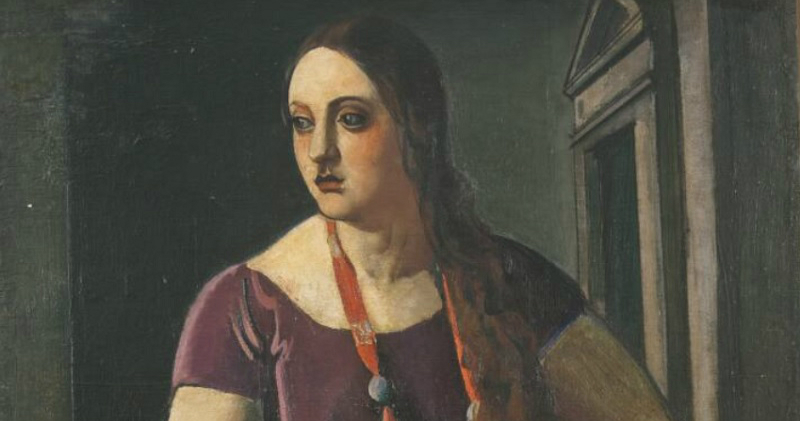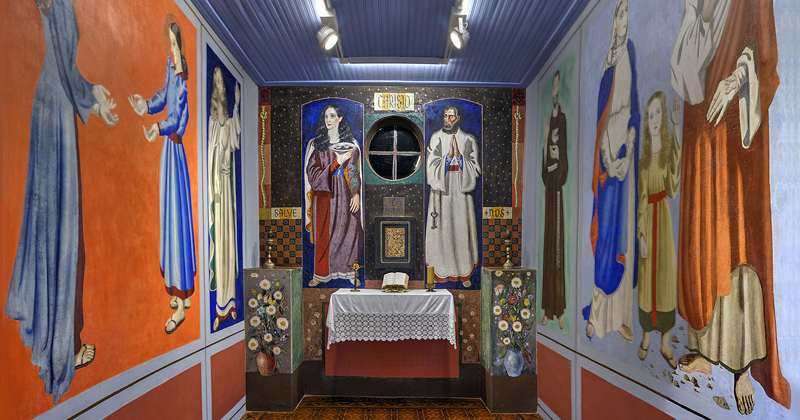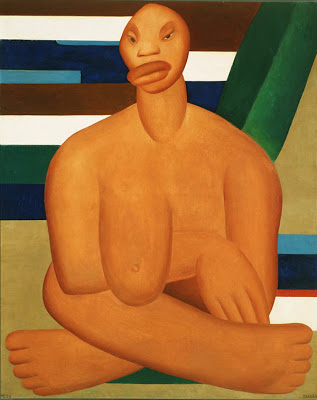Quando física e arte dão as mãos, abre-se um amplo – e colorido – leque de conhecimentos. Na USP, um grupo de pesquisadores já ajudou a desvendar como Portinari combinava os pigmentos para criar as cores de suas telas e encontrou traçados em uma tela do italiano Achille Funi que não aparecem na pintura final.
 Detalhe da tela A adivinha, de Achille Funi: radiografia digitalizada feita pelo Instituto de Física revelou um balcão que não aparece na arte final
Detalhe da tela A adivinha, de Achille Funi: radiografia digitalizada feita pelo Instituto de Física revelou um balcão que não aparece na arte final
 Detalhe da Capela da Nonna no museu Casa de Portinari em Brodowski – Foto: Divulgação/Museu Casa de Portinari
Detalhe da Capela da Nonna no museu Casa de Portinari em Brodowski – Foto: Divulgação/Museu Casa de Portinari


 Detalhe da tela A adivinha, de Achille Funi: radiografia digitalizada feita pelo Instituto de Física revelou um balcão que não aparece na arte final
Detalhe da tela A adivinha, de Achille Funi: radiografia digitalizada feita pelo Instituto de Física revelou um balcão que não aparece na arte final
Radiografia digitalizada, fluorescência de raios X e reflectografia de infravermelho são exemplos de técnicas utilizadas para analisar obras de arte. Mas os pesquisadores do Núcleo de Apoio à Pesquisa (NAP) de Física Aplicada ao Patrimônio Histórico e Artístico (FAEPAH) da Universidade querem fazer muito mais.
Hoje, quando algum museu ou instituição solicita aos cientistas que façam uma determinada análise, dependendo do tipo de demanda, é preciso transportar a obra para os laboratórios do Instituto de Física, onde ficam alguns equipamentos fixos necessários, por exemplo o sistema de radiografia. Alguns outros, no entanto, são portáteis e permitem que parte dos estudos sejam feitos no próprio local – uma vantagem em termos de segurança, conservação e possibilidades de pesquisa.
.
 Detalhe da Capela da Nonna no museu Casa de Portinari em Brodowski – Foto: Divulgação/Museu Casa de Portinari
Detalhe da Capela da Nonna no museu Casa de Portinari em Brodowski – Foto: Divulgação/Museu Casa de Portinari
A coordenadora do núcleo e professora do Instituto de Física (IF) da USP, Márcia de Almeida Rizzutto, explica que o intuito dos pesquisadores é criar um laboratório móvel, como já existe em outros países, para aperfeiçoar as análises. “Queremos uma infraestrutura de pesquisa completa que possa ser montada dentro dos museus”, afirma. Alguns desses equipamentos são mais caros e já foram solicitados em órgãos de fomento, mas os recursos ainda não foram disponibilizados e ainda faltam vários itens para completar o laboratório móvel.
Utilizando um sistema de radiografia portátil, a leitura das obras seria toda digitalizada, exemplifica a professora. Por meio de um sistema sem fio, as informações da imagem da radiografia seguiriam direto para o computador dos pesquisadores. “Assim, faríamos facilmente as análises técnicas e o processamento de informações, para então discutir com os especialistas”, conta Márcia.
A portabilidade de alguns equipamentos foi o que permitiu à pesquisadora estudar a Capela do Museu Casa de Portinari, localizada na cidade de Brodowski, no interior de São Paulo. Lá, o artista pintou murais que seriam impossíveis de transportar até a USP. A pedido do museu, Márcia utilizou técnicas de fluorescência de raios X, Raman e técnicas de imagens multiespectrais como ultravioleta e infravermelho para estudar as obras e seu estado de conservação.

Tarsila na USP
A tela A negra, da pintora Tarsila do Amaral, é uma das obras do acervo do Museu de Arte Contemporânea (MAC) da USP que passaram por análises no Instituto de Física. No próximo ano, a obra será emprestada para uma mostra itinerante nos Estados Unidos, então as imagens de radiografia ajudam a identificar o estado de conservação da obra – um exame muito mais detalhado do que o laudo técnico feito a olho nu – além de revelar parte do processo criativo da artista. Análises em andamento podem identificar a paleta de pigmentos usada pela artista bem como tentar descobrir se há desenhos subjacentes na obra e possíveis correções feitas pela artista.

A Negra, obra de Tarsila do Amaral, integra o acervo do Museu de Arte Contemporânea da USP – Reprodução
O pedido foi feito pela presidente da Comissão de Pesquisa do MAC, Ana Gonçalves Magalhães. “As análises e estudos nos auxiliam em muitos aspectos e dão um apoio imenso à conservação das obras”, afirma. Para a professora, a principal vantagem de um laboratório móvel é evitar o deslocamento das telas e peças, contribuindo para sua preservação.
Além disso, não seria viável para um museu adquirir uma infraestrutura como a proposta pelo Instituto de Física. “É um conjunto de equipamentos caros e, no caso de um único museu, poderia ficar muito tempo ocioso”, observa Ana. Para o Instituto de Física, no entanto, seria uma forma de atender várias instituições e estudar e aperfeiçoar continuamente as tecnologias. Segundo Márcia Rizzutto, mesmo sem todos os equipamentos de um laboratório móvel, os trabalhos estão sendo realizados com uma infraestrutura montada pelos diferentes financiamentos obtidos, mas um laboratório móvel mais bem equipado poderia ajudar muitas instituições com diferentes acervos museológicos.
Cultura e conhecimento são ingredientes essenciais para a sociedade.
A cultura e o amor devem estar juntos.
Vamos compartilhar.
--in via tradutor do google
USP physics wants to create mobile laboratory to analyze works of art.
Screen "A Guess", by Achille Funi: scanned radiography made by the Institute of Physics revealed a counter that does not appear in the final art
Detail of the screen The guess, by Achille Funi: scanned radiography made by the Institute of Physics revealed a counter that does not appear in the final art
.
When physics and art join hands, a wide - and colorful - range of knowledge opens up. At USP, a group of researchers has helped unravel how Portinari combined the pigments to create the colors of his canvases and found traces on an Italian Achille Funi canvas that do not appear in the final painting.
Scanned radiography, X-ray fluorescence, and infrared reflectography are examples of techniques used to analyze artwork. But researchers at the Nucleus of Research Support (NAP) of Physics Applied to Historical and Artistic Patrimony (FAEPAH) of the University want to do much more.
Today, when a museum or institution asks the scientists to make a specific analysis, depending on the type of demand, it is necessary to transport the work to the laboratories of the Institute of Physics, where some fixed equipment is needed, for example the radiography system. Some others, however, are portable and allow part of the studies to be done on the spot - an advantage in terms of security, conservation and research possibilities.
.
Nona Chapel
Detail of Nonna's Chapel at the Casa de Portinari museum in Brodowski - Photo: Press Release / Casa de Portinari Museum
.
The core coordinator and professor at the Institute of Physics (IF) at USP, Márcia de Almeida Rizzutto, explains that researchers intend to create a mobile laboratory, as it already exists in other countries, to improve the analysis. "We want a complete research infrastructure that can be assembled within museums," he says. Some of these equipment are more expensive and have already been requested in development agencies, but the resources have not yet been made available and there are still several items to complete the mobile laboratory.
Using a portable radiography system, the reading of the works would be digitalized, exemplifies the teacher. Through a wireless system, information from the X-ray image would go straight to the researchers' computer. "Thus, we would easily do technical analysis and information processing, and then discuss with the experts," says Márcia.
The portability of some equipment was what allowed the researcher to study the Chapel of the Museum House of Portinari, located in the city of Brodowski, in the interior of São Paulo. There, the artist painted murals that would be impossible to transport to USP. At the request of the museum, Márcia used X-ray fluorescence techniques, Raman techniques and multispectral imaging techniques such as ultraviolet and infrared to study the works and their state of conservation.
Tarsila at USP
Márcia de Almeida Rizzutto analyzes the work "A Negra" by Tarsila do Amaral - Photo: Marcos Santos / USP Images
.
The black screen, by the painter Tarsila do Amaral, is one of the works of the collection of the Museum of Contemporary Art (MAC) of the University of São Paulo (USP), which has been analyzed by the Institute of Physics. Next year, the work will be loaned to a traveling show in the United States, so the radiographs help identify the state of conservation of the work - a much more detailed examination than the technical report done with the naked eye - in addition to revealing part Of the artist's creative process. Ongoing analyzes can identify the pigment palette used by the artist as well as try to find out if there are underlying designs in the work and possible corrections made by the artist.
The Black, work of Tarcila do Amaral - Reproduction
A Negra, by Tarsila do Amaral, is part of the collection of the USP Museum of Contemporary Art - Reproduction
The request was made by the president of the Research Committee of MAC, Ana Gonçalves Magalhães. "The analyzes and studies help us in many ways and give immense support to the conservation of the works," he says. For the teacher, the main advantage of a mobile laboratory is to avoid the displacement of screens and parts, contributing to its preservation.
In addition, it would not be feasible for a museum to acquire an infrastructure such as that proposed by the Institute of Physics. "It's an expensive set of equipment and, in the case of a single museum, it could be idle for a long time," says Ana. For the Institute of Physics, however, it would be a way to serve various institutions and study and continually improve technologies. According to Márcia Rizzutto, even without all the equipment of a mobile laboratory, the works are being carried out with an infrastructure assembled by the different financing obtained, but a better equipped mobile laboratory could help many institutions with different museological collections.


Nenhum comentário:
Postar um comentário